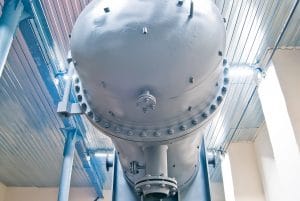 Electrical thermal management used to be straight-forward, to the point where companies used to have little choice in how they accomplish it. For most industrial applications, companies had to rely on solutions like air conditioners or air compressors to stop excess waste heat from gathering inside of electrical enclosures. These days, the goal of preventing damage from overheating is the same, though there are many different options for how to accomplish it. In many cases, custom heat exchangers are often the ideal solution, thanks largely to the natural processes they use to transfer electrical waste heat, such as phase-change cooling.
Electrical thermal management used to be straight-forward, to the point where companies used to have little choice in how they accomplish it. For most industrial applications, companies had to rely on solutions like air conditioners or air compressors to stop excess waste heat from gathering inside of electrical enclosures. These days, the goal of preventing damage from overheating is the same, though there are many different options for how to accomplish it. In many cases, custom heat exchangers are often the ideal solution, thanks largely to the natural processes they use to transfer electrical waste heat, such as phase-change cooling.
A glance at modern phase-change cooling
Phase-change cooling is one of several naturally occurring methods that heat exchangers utilize to transfer heat. Using a cooling fluid’s latent heat of vaporization, heat exchangers allow for the absorption of heat by the fluid to the point where it evaporates, at which point the less dense fluid can flow easily to a cooler area of the heat exchanger. As the fluid absorbs heat and evaporates, it prevents any rise in temperature within the enclosure, keeping it well below an application’s maximum operating temperature. Because transferring heat through phase-change cooling is simpler than traditional cooling methods, the process is much easier to customize the fit the needs of increasingly more complex applications.
Different ways to customize heat transfer
Modern heat exchangers are designed in a variety of ways, including heat pipes and custom-made cold plates. Each unit is designed to achieve maximum thermal management capabilities according to different applications’ unique needs. Heat exchangers that utilize phase-change cooling are also among the most commonly custom-designed units, as thermal management and engineering experts can more effectively achieve the cooling needs they seek at minimal costs. While they’re typically employed to prevent electrical overheating, custom heat exchangers are also adept at other thermal management processes, including providing heat for wastewater treatment, creating isothermal methods of cooling molds, and much more.
The advantages to modern electrical cooling
The greatest benefit of heat exchangers that utilize phase-change cooling is the fact that they can achieve high levels of thermal management without the cumbersome requirements of older, more conventional solutions. The fluid used inside of them is eco-friendly (many models simply use water), and the apparatus designed to carry it (i.e., heat pipes, cold plates, thermal pins, etc.) can fit into tight spaces without losing their efficiency.
For more information about how custom heat exchangers harness phase-change cooling, call Noren Thermal Solutions in Taylor, TX, at 866-936-6736.







